Triad Analysis of Global Energy Trade Networks and Implications for Energy Trade Stability
Abstract
:1. Introduction
1.1. Network Analysis and Global Trade
1.2. Triad Analysis
2. Data and Methods
2.1. Trade Data
2.2. Constructing a Triad Significance Profle (TSP)
3. Results and Discussion
3.1. The Aggregate Energy Trade Network
3.2. Triad Significance Profile (TSP): Motifs and Anti-Motifs
3.3. Network Robustness to Disruption: TSP Integrity under Random Node Removal
3.4. Comparison of Energy Trade to Other Network TSPs
3.5. Disaggregated Energy Trade: Commodity-Specific Trade Networks
3.6. Disaggregated Energy Trade: Country-Specific Triad Significance Profiles
3.7. Policy Implications
3.8. Limitiations of Our Approach and Future Directions
Supplementary Materials
Author Contributions
Funding
Data Availability Statement
Conflicts of Interest
References
- UNEP. Towards a Green Economy: Pathways to Sustainable Development and Poverty Eradication; United Nations Environment Programme: Nairobi, Kenya, 2011. [Google Scholar]
- Rockström, J.; Gaffney, O.; Rogelj, J.; Meinshausen, M.; Nakicenovic, N.; Schellnhuber, H.J. A roadmap for rapid decarbonization. Science 2017, 355, 1269–1271. [Google Scholar] [CrossRef] [Green Version]
- US. National Academies of Sciences, Engineering, and Medicine. Accelerating Decarbonization in the U.S. Energy System; The National Academies Press: Washington, DC, USA, 2021.
- International Energy Agency. Renewables 2021: Analysis and Forecast to 2026; Organisation for Economic Cooperation and Development: Washington, DC, USA, 2021; Available online: https://www.iea.org/reports/renewables-2021 (accessed on 22 March 2022).
- Yang, Y. Energy globalization of China: Trade, investment, and embedded energy flows. J. Geogr. Sci. 2022, 32, 377–400. [Google Scholar] [CrossRef]
- Finley, M. Energy Security and the Energy Transition: A Classic Framework for a New Challenge; Vol. Baker Institute Report no. 11.25.19; Rice University’s Baker Institute for Public Policy: Houst, TX, USA, 2019. [Google Scholar]
- United Nations Statistics Division. UN COMTRADE: International Merchandise Trade Statistics; United Nations: New York, NY, USA, 2021; Available online: http://comtrade.un.org/ (accessed on 24 February 2022).
- De Benedictis, L.; Tajoli, L. The World Trade Network. World Econ. 2011, 34, 1417–1454. [Google Scholar] [CrossRef]
- Derudder, B.; Witlox, F. World City Networks and Global Commodity Chains: An introduction. Glob. Netw. 2010, 10, 1–11. [Google Scholar] [CrossRef] [Green Version]
- Li, X.; Ying Jin, Y.; Chen, G. Complexity and synchronization of the World trade Web. Phys. A Stat. Mech. Its Appl. 2003, 328, 287–296. [Google Scholar] [CrossRef]
- Sacks, M.A.; Ventresca, M.J.; Uzzi, B. Global institutions and networks—Contingent change in the structure of world trade advantage, 1965–1980. Am. Behav. Sci. 2001, 44, 1579–1601. [Google Scholar]
- Serrano, M.A.; Boguna, M. Topology of the world trade web. Phys. Rev. E 2003, 68 Pt 2, 015101. [Google Scholar] [CrossRef] [Green Version]
- De Benedictis, L.; Tajoli, L. Comparing sectoral international trade networks. Aussenwirtschaft 2010, 65, 167–189. [Google Scholar]
- Shutters, S.T.; Muneepeerakul, R. Agricultural Trade Networks and Patterns of Economic Development. PLoS ONE 2012, 7, e39756. [Google Scholar] [CrossRef]
- Sartori, M.; Schiavo, S. Connected we stand: A network perspective on trade and global food security. Food Policy 2015, 57, 114–127. [Google Scholar] [CrossRef] [Green Version]
- Wang, J.; Dai, C. Evolution of Global Food Trade Patterns and Its Implications for Food Security Based on Complex Network Analysis. Foods 2021, 10, 2657. [Google Scholar]
- Hou, W.; Liu, H.; Wang, H.; Wu, F. Structure and patterns of the international rare earths trade: A complex network analysis. Resour. Policy 2018, 55, 133–142. [Google Scholar] [CrossRef]
- Berdysheva, S.; Ikonnikova, S. The Energy Transition and Shifts in Fossil Fuel Use: The Study of International Energy Trade and Energy Security Dynamics. Energies 2021, 14, 5396. [Google Scholar] [CrossRef]
- Dalin, C.; Konar, M.; Hanasaki, N.; Rinaldo, A.; Rodriguez-Iturbe, I. Evolution of the global virtual water trade network. Proc. Natl. Acad. Sci. USA 2012, 109, 5989–5994. [Google Scholar] [CrossRef] [Green Version]
- Konar, M.; Dalin, C.; Suweis, S.; Hanasaki, N.; Rinaldo, A.; Rodriguez-Iturbe, I. Water for food: The global virtual water trade network. Water Resour. Res. 2011, 47, W05520. [Google Scholar] [CrossRef] [Green Version]
- Suweis, S.; Konar, M.; Dalin, C.; Hanasaki, N.; Rinaldo, A.; Rodriguez-Iturbe, I. Structure and controls of the global virtual water trade network. Geophys. Res. Lett. 2011, 38, L10403. [Google Scholar] [CrossRef] [Green Version]
- Chen, B.; Li, J.S.; Wu, X.F.; Han, M.Y.; Zeng, L.; Li, Z.; Chen, G.Q. Global energy flows embodied in international trade: A combination of environmentally extended input–output analysis and complex network analysis. Appl. Energy 2018, 210, 98–107. [Google Scholar] [CrossRef]
- Zhong, W.; An, H.; Shen, L.; Fang, W.; Gao, X.; Dong, D. The roles of countries in the international fossil fuel trade: An emergy and network analysis. Energy Policy 2017, 100, 365–376. [Google Scholar] [CrossRef]
- Scienceman, D.M. Energy and Emergy. In Environmental Economics: The Analysis of a Major Interface; Pillet, G., Murota, T., Eds.; R. Leimgruber: Geneva, Switzerland, 1987; pp. 257–276. [Google Scholar]
- Garlaschelli, D.; Di Matteo, T.; Aste, T.; Caldarelli, G.; Loffredo, M.I. Interplay between topology and dynamics in the World Trade Web. Eur. Phys. J. B 2007, 57, 159–164. [Google Scholar] [CrossRef]
- Reyes, J.; Fagiolo, G.; Schiavo, S. Using a Complex Weighted-Network Approach to Assess the Evolution of International Economic Integration: The Cases of East Asia and Latin America; Sant’Anna School of Advanced Studies: Pisa, Italy, 2008. [Google Scholar]
- Distefano, T.; Laio, F.; Ridolfi, L.; Schiavo, S. Shock transmission in the International Food Trade Network. PLoS ONE 2018, 13, e0200639. [Google Scholar] [CrossRef] [Green Version]
- Piccardi, C.; Tajoli, L. Complexity, centralization, and fragility in economic networks. PLoS ONE 2018, 13, e0208265. [Google Scholar] [CrossRef]
- Wong, H.; Lu, Y.; Wang, F.; Landis, S.; Simmons, R.; Shutters, S.T.; Maciejewski, R. A Visual Analytics Framework for Spatiotemporal Trade Network Analysis. IEEE Trans. Vis. Comput. Graph. 2019, 25, 331–341. [Google Scholar] [CrossRef]
- Gao, C.; Sun, M.; Shen, B. Features and evolution of international fossil energy trade relationships: A weighted multilayer network analysis. Appl. Energy 2015, 156, 542–554. [Google Scholar] [CrossRef]
- Lu, W.; Su, M.; Zhang, Y.; Yang, Z.; Chen, B.; Liu, G. Assessment of energy security in China based on ecological network analysis: A perspective from the security of crude oil supply. Energy Policy 2014, 74, 406–413. [Google Scholar] [CrossRef]
- Yang, Y.; Poon, J.P.H.; Liu, Y.; Bagchi Sen, S. Small and flat worlds: A complex network analysis of international trade in crude oil. Energy 2015, 93, 534–543. [Google Scholar]
- Zhong, W.; An, H.; Gao, X.; Sun, X. The evolution of communities in the international oil trade network. Phys. A Stat. Mech. Its Appl. 2014, 413, 42–52. [Google Scholar] [CrossRef]
- Semanur, S.; Hüseyin, T.; Halil, Ö. An Alternative View to the Global Coal Trade: Complex Network Approach. Stud. Bus. Econ. 2020, 15, 270–288. [Google Scholar] [CrossRef]
- Wang, W.; Li, Z.; Cheng, X. Evolution of the global coal trade network: A complex network analysis. Resour. Policy 2019, 62, 496–506. [Google Scholar] [CrossRef]
- Milo, R.; Shen-Orr, S.; Itzkovitz, S.; Kashtan, N.; Chklovskii, D.; Alon, U. Network motifs: Simple building blocks of complex networks. Science 2002, 298, 824–827. [Google Scholar]
- Holland, P.W.; Leinhardt, S. A Method for Detecting Structure in Sociometric Data. Am. J. Sociol. 1970, 76, 492–513. [Google Scholar]
- Prell, C.; Skvoretz, J. Looking at Social Capital through Triad Structures. Connections 2008, 28, 4–16. [Google Scholar]
- Faust, K. A puzzle concerning triads in social networks: Graph constraints and the triad census. Soc. Netw. 2010, 32, 221–233. [Google Scholar] [CrossRef]
- Milo, R.; Itzkovitz, S.; Kashtan, N.; Levitt, R.; Shen-Orr, S.; Ayzenshtat, I.; Sheffer, M.; Alon, U. Superfamilies of evolved and designed networks. Science 2004, 303, 1538–1542. [Google Scholar]
- Waters, J.S.; Fewell, J.H. Information Processing in Social Insect Networks. PLoS ONE 2012, 7, e40337. [Google Scholar] [CrossRef]
- Kaluza, P.; Kölzsch, A.; Gastner, M.T.; Blasius, B. The complex network of global cargo ship movements. J. R. Soc. Interface 2010, 7, 1093–1103. [Google Scholar] [CrossRef]
- Kashtan, N.; Itzkovitz, S.; Milo, R.; Alon, U. Mfinder Version 1.2: Network Motifs Detection Tool. 2005. Available online: https://www.weizmann.ac.il/mcb/UriAlon/download/network-motif-software (accessed on 14 November 2021).
- Facchetti, G.; Iacono, G.; Altafini, C. Computing global structural balance in large-scale signed social networks. Proc. Natl. Acad. Sci. USA 2011, 108, 20953–20958. [Google Scholar] [CrossRef] [Green Version]
- Granovetter, M. The Strength of Weak Ties. Am. J. Sociol. 1973, 78, 1360–1380. [Google Scholar]
- Rapoport, A. Spread of information through a population with socio-structural bias: I. Assumption of transitivity. Bull. Math. Biophys. 1953, 15, 523–533. [Google Scholar] [CrossRef]
- Mangan, S.; Alon, U. Structure and function of the feed-forward loop network motif. Proc. Natl. Acad. Sci. USA 2003, 100, 11980–11985. [Google Scholar] [CrossRef] [Green Version]
- McGee, S.R.; Tibiche, C.; Trifiro, M.; Wang, E. Network Analysis Reveals A Signaling Regulatory Loop in the PIK3CA-mutated Breast Cancer Predicting Survival Outcome. Genom. Proteom. Bioinform. 2017, 15, 121–129. [Google Scholar] [CrossRef]
- Whitten, G.; Dai, X.; Fan, S.; Pang, Y. Do political relations affect international trade? Evidence from China’s twelve trading partners. J. Shipp. Trade 2020, 5, 21. [Google Scholar] [CrossRef]
- Balza, L.H.; Brearley, E.; Clarke, D.; Gauto, V. Traversing a Slipery Slope: Guyana’s Oil Opportunity (IDB Technical Note 1994); Inter-American Development Bank, Infrastucture and Energy Sector: Washington, DC, USA, 2020. [Google Scholar]
- Calvert, K. From ‘energy geography’ to ‘energy geographies’:Perspectives on a fertile academic borderland. Prog. Hum. Geogr. 2016, 40, 105–125. [Google Scholar] [CrossRef]
- Faust, K. Comparing social networks: Size, density, and local structure. Metodoloski Zv. 2006, 3, 185–216. [Google Scholar]

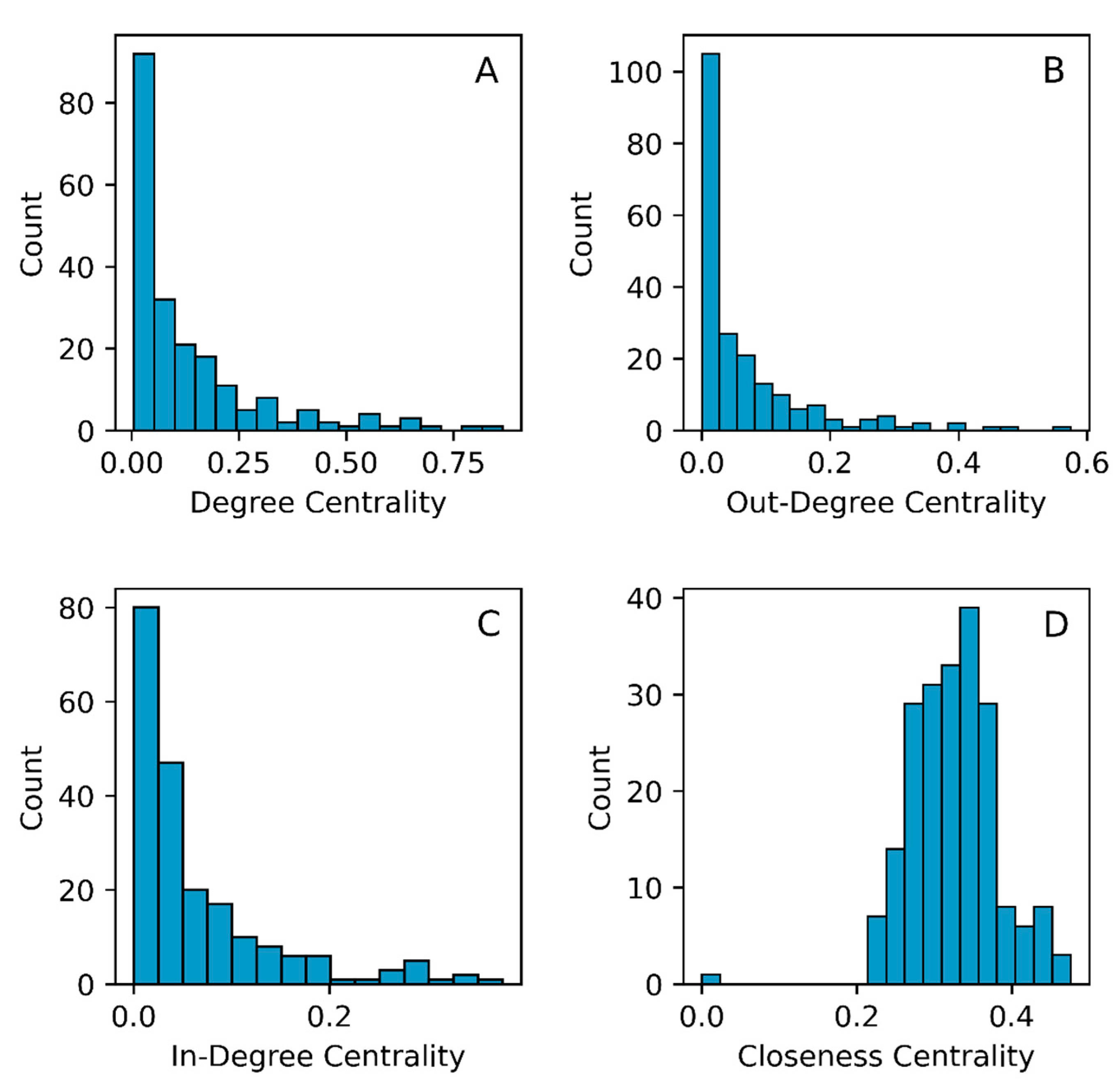
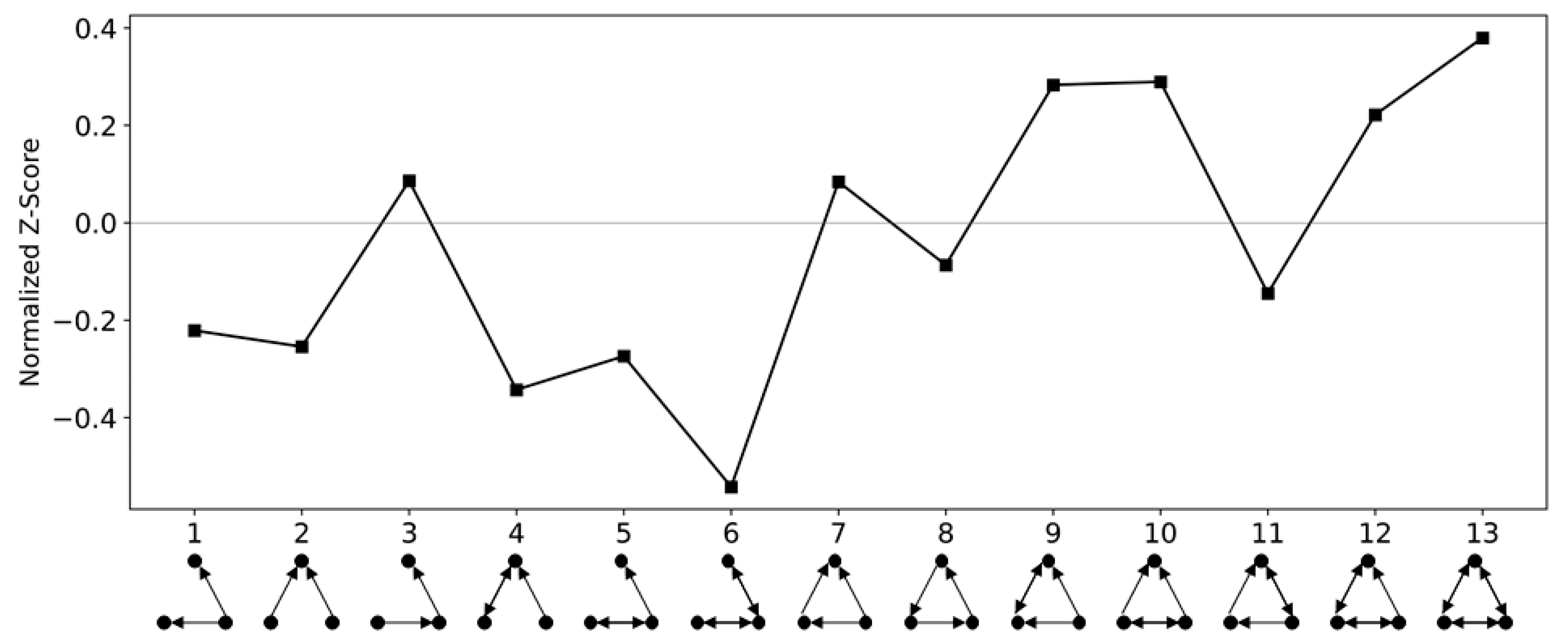
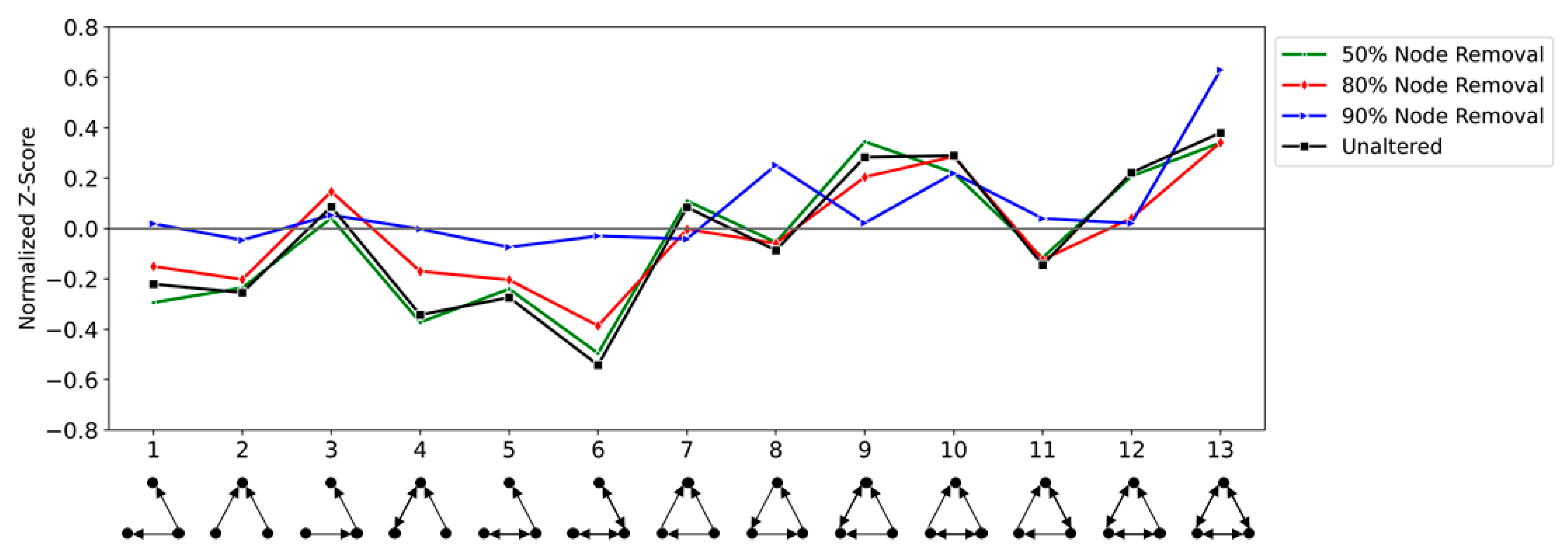
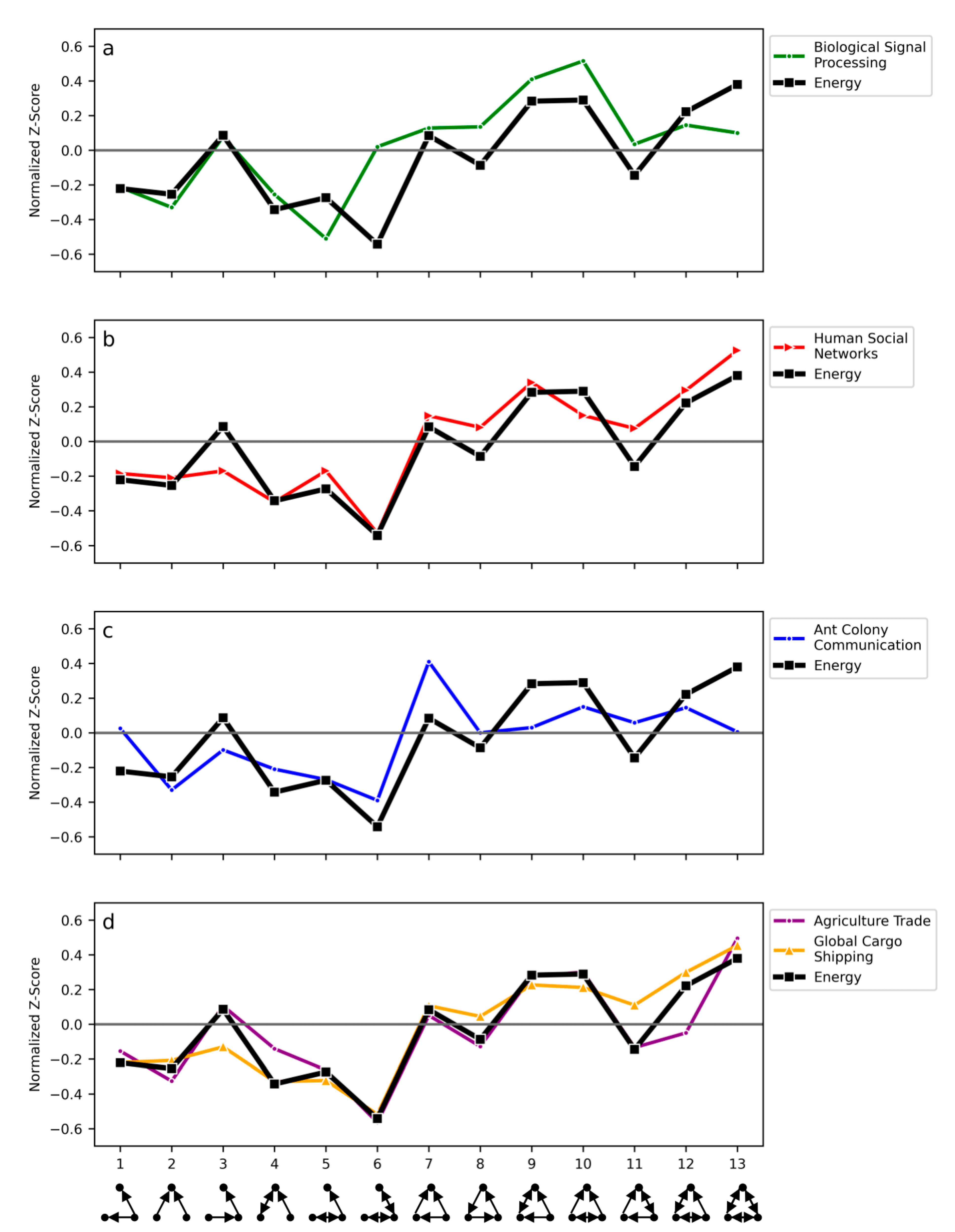
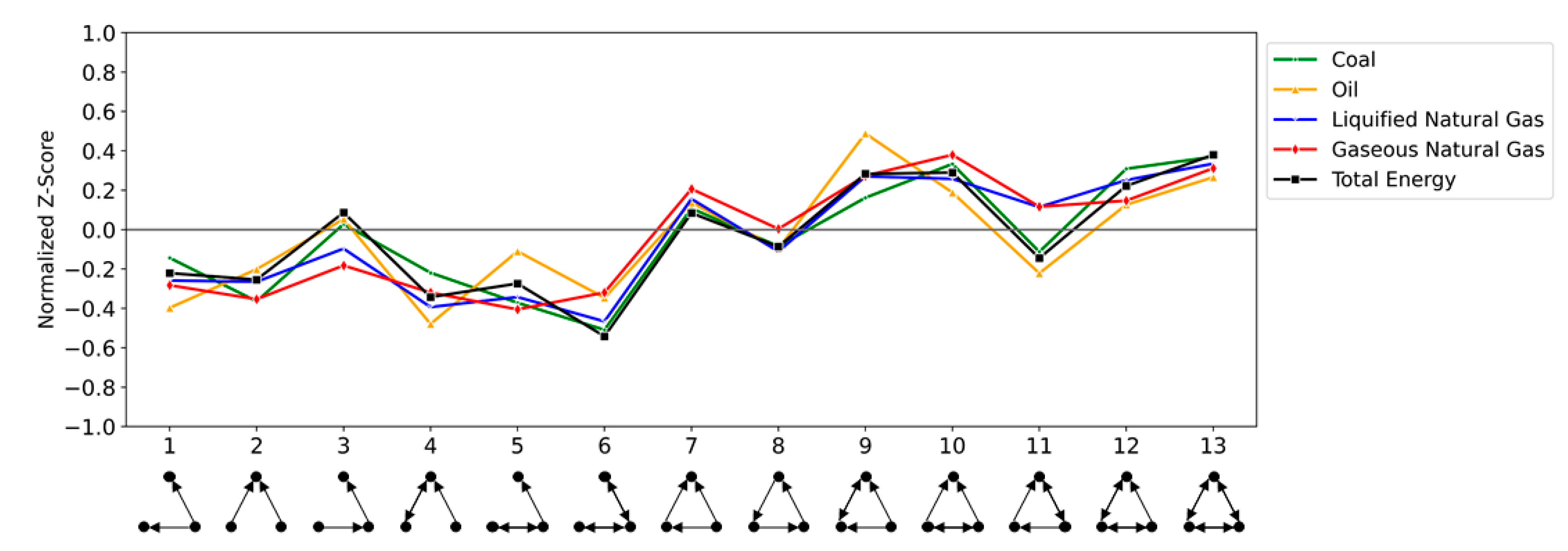

| Commodity | Top Exporters | $ | Top Importers | $ |
|---|---|---|---|---|
| Coal | Australia | 43 | Japan | 21 |
| Indonesia | 20 | India | 21 | |
| Russia | 18 | China | 19 | |
| Oil | Saudi Arabia | 162 | China | 225 |
| Russia | 124 | USA | 128 | |
| Iraq | 81 | India | 96 | |
| Gaseous | Norway | 20 | Italy | 14 |
| Natural Gas | Russia | 18 | China | 13 |
| Turkmenistan | 9 | Germany | 9 | |
| Liquid | Qatar | 38 | Japan | 40 |
| Natural Gas | Australia | 36 | China | 29 |
| USA | 10 | South Korea | 21 |
| Biological Signal Processing Networks | Human Social Networks | Global Agricultural Trade | Cargo Shipping—Average | Ant Colony Communications | Energy Trade—Aggregate | Energy Trade—Coal | Energy Trade—Oil | Energy Trade—Liquid Natural Gas | Energy Trade—Gaseous Natural Gas | Energy Trade—Country Cluster 1 | Energy Trade—Country Cluster 2 | Energy Trade—Country Cluster 3 | Energy Trade—Country Cluster 4 | |
|---|---|---|---|---|---|---|---|---|---|---|---|---|---|---|
| biological signal processing networks | 1 | 0.59 | 0.63 | 0.67 | 0.60 | 0.71 | 0.73 | 0.69 | 0.75 | 0.86 | 0.36 | 0.57 | 0.51 | 0.27 |
| human social networks | 0.59 | 1 | 0.82 | 0.98 | 0.69 | 0.91 | 0.88 | 0.82 | 0.94 | 0.88 | 0.28 | 0.90 | 0.38 | 0.24 |
| global agricultural trade | 0.63 | 0.82 | 1 | 0.83 | 0.60 | 0.93 | 0.90 | 0.78 | 0.83 | 0.80 | 0.38 | 0.90 | 0.19 | 0.32 |
| cargo shipping— average | 0.67 | 0.98 | 0.83 | 1 | 0.73 | 0.92 | 0.92 | 0.79 | 0.97 | 0.92 | 0.34 | 0.88 | 0.46 | 0.22 |
| ant colony communications | 0.60 | 0.69 | 0.60 | 0.73 | 1 | 0.69 | 0.76 | 0.53 | 0.77 | 0.78 | 0.04 | 0.70 | 0.37 | 0.32 |
| energy trade— aggregate | 0.71 | 0.91 | 0.93 | 0.92 | 0.69 | 1 | 0.96 | 0.90 | 0.94 | 0.87 | 0.44 | 0.94 | 0.29 | 0.34 |
| energy trade— coal | 0.73 | 0.88 | 0.90 | 0.92 | 0.76 | 0.96 | 1 | 0.78 | 0.92 | 0.89 | 0.36 | 0.91 | 0.34 | 0.37 |
| energy trade— oil | 0.69 | 0.82 | 0.78 | 0.79 | 0.53 | 0.90 | 0.78 | 1 | 0.84 | 0.79 | 0.47 | 0.83 | 0.29 | 0.26 |
| energy trade— liquid natural gas | 0.75 | 0.94 | 0.83 | 0.97 | 0.77 | 0.94 | 0.92 | 0.84 | 1 | 0.96 | 0.35 | 0.88 | 0.45 | 0.27 |
| energy trade— gaseous natural gas | 0.86 | 0.88 | 0.80 | 0.92 | 0.78 | 0.87 | 0.89 | 0.79 | 0.96 | 1 | 0.28 | 0.79 | 0.53 | 0.30 |
| energy trade— country cluster 1 | 0.36 | 0.28 | 0.38 | 0.34 | 0.04 | 0.44 | 0.36 | 0.47 | 0.35 | 0.28 | 1 | 0.19 | 0.33 | −0.43 |
| energy trade— country cluster 2 | 0.57 | 0.90 | 0.90 | 0.88 | 0.70 | 0.94 | 0.91 | 0.83 | 0.88 | 0.79 | 0.19 | 1 | 0.21 | 0.39 |
| energy trade— country cluster 3 | 0.51 | 0.38 | 0.19 | 0.46 | 0.37 | 0.29 | 0.34 | 0.29 | 0.45 | 0.53 | 0.33 | 0.21 | 1 | −0.49 |
| energy trade— country cluster 4 | 0.27 | 0.24 | 0.32 | 0.22 | 0.32 | 0.34 | 0.37 | 0.26 | 0.27 | 0.30 | −0.43 | 0.39 | −0.49 | 1 |
| Country | Z6 | Cluster | Country | Z13 | Cluster |
|---|---|---|---|---|---|
| Malta | 0.41 | 1 | Iran | −0.56 | 3 |
| Côte d’Ivoire | 0.33 | 1 | Israel | −0.39 | 4 |
| Saint Lucia | 0.27 | 4 | Dem. Rep. of the Congo | −0.36 | 3 |
| Niger | 0.23 | 3 | Serbia | −0.31 | 1 |
| Ghana | 0.22 | 1 | Moldova | −0.28 | 3 |
| Mexico | 0.21 | 4 | Guatemala | −0.27 | 4 |
| Dem. Rep. of the Congo | 0.19 | 3 | Uzbekistan | −0.25 | 1 |
| Belize | 0.17 | 4 | Madagascar | −0.23 | 4 |
| Tunisia | 0.17 | 2 | Azerbaijan | −0.23 | 1 |
| Bosnia Herzegovina | −0.22 | 4 | |||
| Trinidad and Tobago | −0.19 | 1 | |||
| Zambia | −0.16 | 2 | |||
| Jordan | −0.15 | 4 |
Publisher’s Note: MDPI stays neutral with regard to jurisdictional claims in published maps and institutional affiliations. |
© 2022 by the authors. Licensee MDPI, Basel, Switzerland. This article is an open access article distributed under the terms and conditions of the Creative Commons Attribution (CC BY) license (https://creativecommons.org/licenses/by/4.0/).
Share and Cite
Shutters, S.T.; Waters, K.; Muneepeerakul, R. Triad Analysis of Global Energy Trade Networks and Implications for Energy Trade Stability. Energies 2022, 15, 3673. https://doi.org/10.3390/en15103673
Shutters ST, Waters K, Muneepeerakul R. Triad Analysis of Global Energy Trade Networks and Implications for Energy Trade Stability. Energies. 2022; 15(10):3673. https://doi.org/10.3390/en15103673
Chicago/Turabian StyleShutters, Shade T., Keith Waters, and Rachata Muneepeerakul. 2022. "Triad Analysis of Global Energy Trade Networks and Implications for Energy Trade Stability" Energies 15, no. 10: 3673. https://doi.org/10.3390/en15103673
APA StyleShutters, S. T., Waters, K., & Muneepeerakul, R. (2022). Triad Analysis of Global Energy Trade Networks and Implications for Energy Trade Stability. Energies, 15(10), 3673. https://doi.org/10.3390/en15103673







